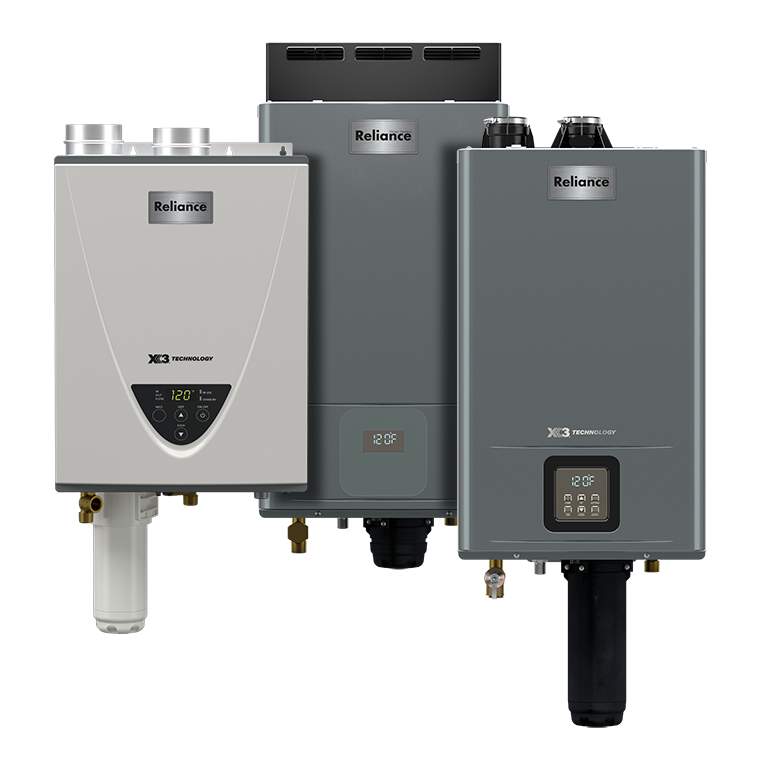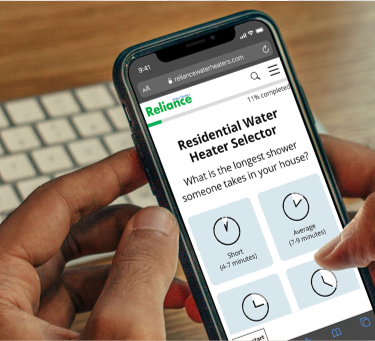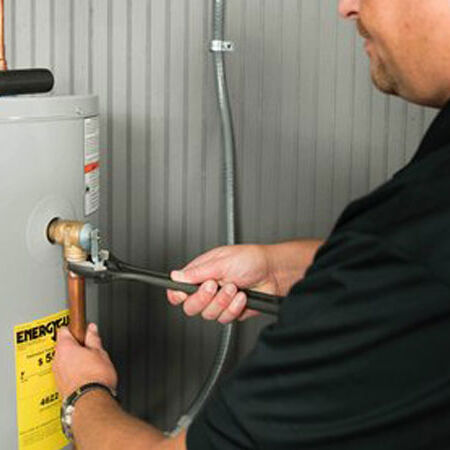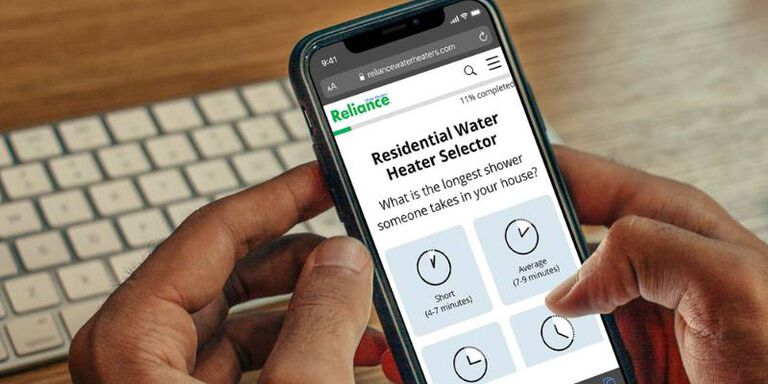.jpg?cx=1265&cy=0&cw=468&ch=625)
How to Choose the Right Water Heater: Tankless Water Heater Buying Guide
Tankless water heaters deliver more hot water while using less energy, helping you save on energy, space, and cost.
This buying guide explores the key features of these water heaters and provides tips on selecting the best tankless water heater for your home's needs.
What is a Tankless Water Heater?

A tankless water heater heats water only when you need it, and it can heat water for your entire home or just a single point. You'll need to figure out the first two differentiations below first.
1. Selecting a Power Source
Tankless water heaters are designed to provide an endless source of hot water, all while saving you money on energy costs. They come in natural gas, liquid propane, or electric models.
2. Deciding on Condensing or Non-Condensing:
Condensing gas tankless maximizes system energy by utilizing a dual heat exchanger. Non-condensing models only have one heat exchanger. Condensing systems are more energy-efficient, as less heat is lost in the process of heating the water.
How Does a Tankless Water Heater Work?
When you run any water tap in your home, your tankless water heater will recognize the need for hot water and start the heating process. The water heater then figures out the incoming water temperature and uses it to determine how much heat the elements must produce to deliver water at the set temperature. Once demand ceases, the water heater shuts down and stops using energy, waiting until you need more hot water. The result is that you’re no longer limited to the amount of hot water available in your tank.

Find Your Local Retailer
Reliance is sold at numerous neighborhood retail locations throughout the U.S.
Choosing the Right Tankless Water Heater
Choosing the right tankless water heater for your home requires careful consideration, particularly when it comes to sizing. A water heater that’s too small may struggle to meet your household’s hot water demands, while an oversized model can lead to unnecessary expenses.
To ensure a sufficient hot water supply, select a tankless water heater that can accommodate peak usage—such as running a dishwasher, taking a shower, and doing laundry simultaneously. This requires understanding two key factors: flow rate and temperature rise.
Flow rate is measured in gallons per minute (GPM) and indicates how much water flows through a fixture or appliance.
Temperature rise is the difference between the incoming groundwater temperature and the desired hot water output.
Before purchasing a tankless water heater, determine these values, consult sizing charts, and factor in your budget to find the best fit for your home.
Average GPM Usage for Common Appliances and Fixtures:
Based on the chart above, the total flow rate for peak usage while using the shower, kitchen sink, and a high-efficiency washing machine is 6.0 GPM.
Temperature Rise
Groundwater temperature varies across North America, ranging from the mid-30s to the upper 70s (°F). The continent is divided into three climate zones based on average groundwater temperatures:
- Northern Zone: 37°F to 51°F
- Central Zone: 52°F to 61°F
- Southern Zone: 62°F to 77°F
Since typical household water temperatures range between 110°F and 120°F, calculating the temperature rise is essential. Subtract the incoming groundwater temperature from your desired hot water temperature. For instance, if your groundwater temperature is 57°F and you want a shower temperature of 120°F, the required temperature rise is 63°F.
Benefits of a Tankless Water Heater
A tankless water heater can accommodate any lifestyle, supplying hot water on demand, and has the following main benefits:
Lower Energy Bills
Take advantage of up to 40% energy savings with a tankless water heater compared to a standard gas tank water heater*. These water heaters feature a highly efficient design, as they only heat water when needed.
Longevity
Tankless water heaters typically last up to 20 years with proper maintenance, which is often twice as long as a tank water heater. The expanded lifespan means you spend less money on repairs and replacements.
Space Savings
Tank water heaters can take up to 16 square feet of floor space. Many tankless water heaters are approximately the size of a carry-on suitcase and can be installed on the wall, either inside or outside your home.
Budget Considerations
Tankless water heaters generally have a higher initial cost than traditional models. While tank water heaters range from $500 to $2,000, tankless water heaters typically start at around $1,000 and increase in price from there. However, they offer long-term savings through reduced energy consumption, lower maintenance, and fewer repairs, making them a cost-effective option for many households.
Installation costs vary depending on whether your home's plumbing is already compatible with a tankless system or requires modifications.

Don't Know What Water Heater To Buy?
Use our Water Heater Selector to find the best model for your family's needs.
Types of Tankless Water Heaters
There are two main types of tankless water heaters available, point of use (POU), and whole home tankless water heaters.
Electric Point of Use Water Heaters
Sometimes, a specific area of your home requires an extra boost of hot water. That’s where a point-of-use tankless water heater can help. For example, if you have a sink in a workshop that needs hot water, a point-of-use water heater can be installed nearby to provide instant heating. These small, tankless water heaters are designed to supply hot water to a single fixture or appliance.
Whole Home Tankless Water Heaters
There is a variety of gas and electric tankless water heaters that are designed to deliver enough hot water for an entire household. Gas tankless water heaters range from 140,000 BTU to 199,000 BTU, depending on the amount of hot water needed for a home or business. Whole-home electric tankless water heaters are available in 240-volt models, with kilowatt (kW) ranges of 14 - 32 kW. The higher the kilowatt, the more hot water can be delivered to a home.
How to Install a Tankless Water Heater
If you have expertise in plumbing and electricity, you may be able to install a tankless water heater yourself. We always recommend contacting a certified professional for the safest and most accurate installation. The following are the basic steps to installing a tankless unit. Please refer to the product's manual for specific directions for a safe and proper installation:
- Choose a Location:
- Select a spot near both a water inlet and an electrical or gas connection.
- Prepare for Installation:
- Shut off the power and water supply to the area.
- Disconnect and remove your old water heater.
- Follow the manufacturer’s instructions to prepare the new water heater for installation.
- Install any necessary new water lines.
- Install the Water Heater:
- Double-check all fittings to prevent leaks.
- Connect the water heater to the power supply.
- If required, install proper ventilation.
- Mount the water heater securely in the chosen location.
- Final Setup and Testing:
- Connect the water lines.
- Turn the water and power back on.
- Test the water heater to ensure proper operation.
- Adjust the temperature as needed.
- Verify that all connections and ventilation are functioning properly.
For a safe installation, we recommend contacting your local plumbing professional to assist in installing your water heater. Your local retailer may be able to assist you with finding a pro in your area.
Maintaining the Tankless Water Heater You Choose
With tankless water heaters, you still need to perform a few basic tasks annually to ensure energy efficiency and safe operation:
- Cleaning the filter: Tankless water heaters have inlet filters that keep debris out of the water heater, and these filters require regular cleaning. Removing any debris reduces risks of clogging and ensures water flows through your water heater uninterrupted.
- Monitor water pressure: Monitor the water pressure regularly to ensure it stays in the optimum range noted in the manufacturer’s guidelines.
- Inspect ventilation systems: If you have a tankless water heater that uses natural gas or LP for fuel, you should check the ventilation system annually. Look for obvious problems like obstructions, blockages and loose connections, and inspect closely for signs of damage or corrosion.
- Descaling the water heater: Gas tankless water heaters will build up scale in the heat exchanger if the water is not treated. It is important to descale a tankless water heater when the flow rate starts to drop.
Some Reliance gas tankless models come with X3® Scale Prevention Technology built in. This means virtually zero lifetime descaling maintenance and three times longer product life.
When buying a tankless water heater, take into account the size of your house, the water-flow rate of your faucets, the temperature of the water before it heats up and how hot you want your water to be.

Not sure which water heater is right for you?
Use our Buyer’s Guide to choose the correct model for your family’s home.

Find Your Neighborhood Retail Store Location
For more than 40 years, Reliance Water Heaters has been committed to delivering dependable water heaters. Order from a trusted retailer near you.

